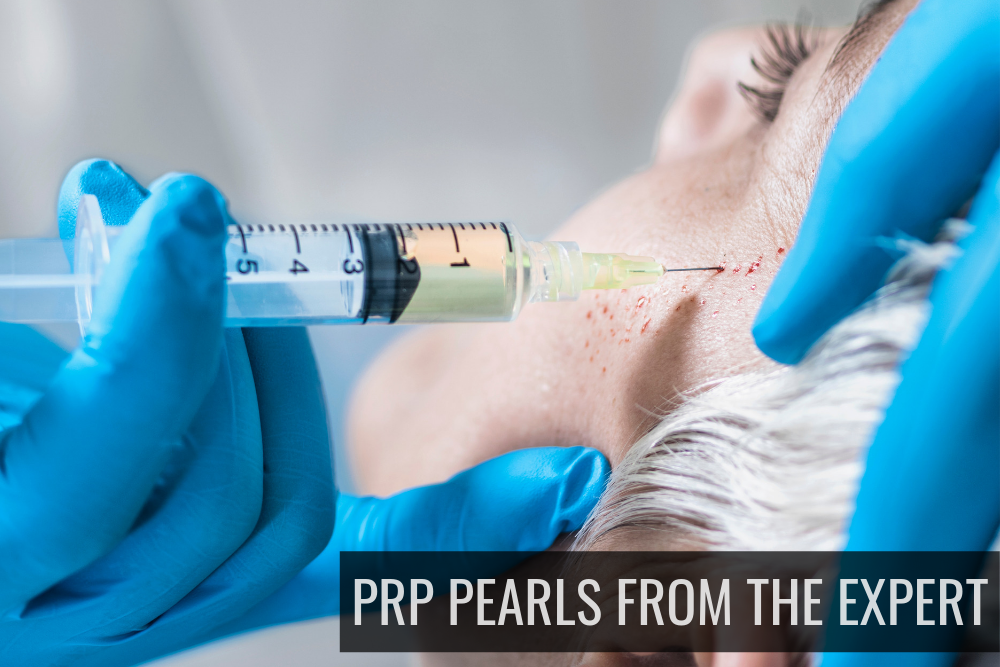Dr. Deirdre Hooper, an expert aesthetic and medical dermatologist, discussed the emerging use of Platelet-rich Plasma in the treatment of alopecia and skin rejuvenation at the 16th Annual ODAC Dermatology, Aesthetics and Surgical Conference. Dr. Nikhil Shyam shares his takeaways and pearls from this lecture.
Platelet-rich plasma (PRP) is rapidly gaining popularity amongst dermatologists for its potential use in treating hair loss, acne scarring and facial rejuvenation. However, there is significant variability in the processing of PRP and there are currently no established treatment protocols.
What is PRP?
- The process of obtaining Platelet-rich plasma or PRP begins with collection of blood from the patient through venipuncture.
- The blood is centrifuged, and its components separate based on specific gravity with red blood cells at the bottom, a buffy coat with white blood cells in the middle and the platelet plasma at the top. PRP is obtained by using only the top layer.
- PRP typically has a higher concentration of platelets compared to whole blood.
- PRP contains numerous growth factors such that are presumed to play a role in its beneficial effects. PRP may stimulate cells in the dermal papilla resulting in increased hair density and thickness. PRP is also thought to play a role in stimulating fibroblasts that can help with collagen remodeling.
Evidence for PRP in Treating Hair Loss and Skin Rejuvenation
- The literature review for the use of PRP in androgenetic alopecia shows significant benefit without any serious complications. However, the data also reveals wide ranging processing systems for PRP and treatment protocols1
- PRP may be used topically or intradermally in combination with fractional ablative laser resurfacing to enhance skin rejuvenation and acne scarring with faster recovery between treatments2.
- PRP has also been shown to improve the cosmetic outcome of striae with high patient satisfaction3.
Practical Tips for Using PRP in Hair Loss:
- Use about 5 – 7 ml PRP
- Inject intradermally or in the deep subcutaneous tissue
- Inject 0.3 to 0.5 cc per area using a 27- or 30-gauge needle
- Typically perform 3-4 treatment sessions every 4-6 weeks
- Maintenance treatments every 6 to 9 months
Practical Tips for Using PRP in Skin Rejuvenation:
- Apply topical numbing medication to the target areas.
- Inject PRP using a 1 cc syringe and a 25 or 27 gauge, 1.5” cannula.
- Utilize a fanning technique to inject in the problem area.
- Alternatively, use a 30-31-gauge needle and inject intradermal blebs.
- Perform 3-4 treatment sessions in 4-6 week intervals.
- Maintenance treatments every 6 to 9 months.
Patient Instructions After Treatment:
- May experience some burning or stinging 5-15 minutes post procedure.
- May result in potential “bleeding” appearance and recommend patients bring hats.
- Avoid strenuous exercise for about 24 hours post procedure.
Overall, PRP is increasingly being utilized for hair loss, scarring and facial rejuvenation. Currently, PRP appears to be safe with no long-term side effects noted. It may be used synergistically with existing treatment options with added benefit. Further research is required to establish the optimal PRP processing technique and to establish standardized treatment protocols.
This information was presented by Dr. Deirdre Hooper at the 16th Annual ODAC Dermatology, Aesthetics and Surgical Conference held January 18th-21st, 2019 in Orlando, FL. The above highlights from her lecture were written and compiled by Dr. Nikhil Shyam, one of the 5 residents selected to participate in the Sun Resident Career Mentorship Program (a program supported by an educational grant from Sun Pharmaceutical Industries, Inc.). Dr. Shyam is a PGY-4 at Johns Hopkins Dermatology Residency Program
References:
- Motosko CC, Khouri KS, Poudrier G, Sinno S, Hazen A. Evaluating Platelet-Rich Therapy for Facial Aesthetics and Alopecia: A Critical Review of the Literature. Plast Reconstr Surg. 2018 May;141(5):1115-1123.
- Gawdat HI, Hegazy RA, Fawzy MM, Fathy M. Autologous platelet rich plasma: topical versus intradermal after fractional ablative carbon dioxide laser treatment of atrophic acne scars. Dermatol Surg. 2014 Feb;40(2):152-61.
- Gamil HD, Ibrahim SA, Ebrahim HM, Albalat W. Platelet-Rich Plasma Versus Tretinoin in Treatment of Striae Distensae: A Comparative Study. Dermatol Surg. 2018 May;44(5):697-704

